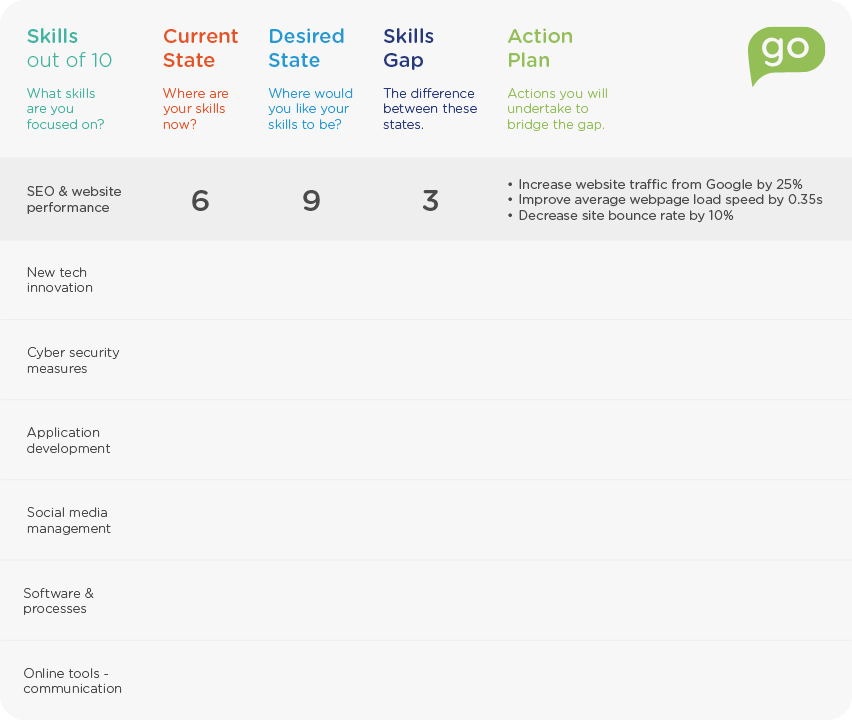The need for digital skills is constantly increasing, especially in a time when we are so reliant on technology and internet services.
The problem here is the UK IT skills shortage which is caused by a skills gap in the digital industry…
Looking for our Australian site?

The need for digital skills is constantly increasing, especially in a time when we are so reliant on technology and internet services.
The problem here is the UK IT skills shortage which is caused by a skills gap in the digital industry…
To define a skills gap, it refers to the difference between the skills required for a job and the skills employees actually possess.
As an employer, it is your responsibility to conduct a skills gap analysis for your company and see if any lack of IT skills in your company could be affecting the productivity and quality of your business.
Another issue with an IT skills gap is that there is a diversity divide between the training of new employees with a lack of skills and no experience.
Government statistics have revealed that graduates are 3 times more likely to receive training than those with no qualifications.
Meanwhile, professionals and managers are about twice as likely to receive training than lower-skilled workers.
The unfair advantage of education and experience over those with a lack of experience should be highlighted and addressed by the employer to encourage diversity in the workplace.
The way to resolve this issue is by offering individuals with less experience and fewer skills, the opportunity to learn.
As an employer, you have the authority to conduct a skill gap analysis report within your business.
Once you are able to locate where the gaps are in the business, then you may notice a relationship between the skills gaps and the performance gaps in your company.
Looking for diversity development in the workplace is a great opportunity to expand your business potential.
Hiring new talent from a variety of backgrounds, generations, minority groups and a variety of experiences is a great way to bring innovative, fresh ideas and a higher work ethic from a huge pool of high-potential and underutilised talent.
Inclusive hiring practices are a great way to close the opportunity gap and improve the success of your business.
With thousands of candidates on our database, we have a diverse talent pool made up of talented and driven graduates.
So whether you’re hiring for Fashion jobs or are in need of a Sales recruitment agency, we can find perfectly matched candidates for your vacanies.
Conducting an employee skills gap analysis is a great way to start pinpointing how your company can boost efficiency and increase its training.
If you are wondering how to do a skills gap analysis, the first thing to do would be to find an employee skills gap analysis template.
Lucky for you, we have created a digital skills gap template for you! As well as filling out the table yourself, it is also a good idea to ask your employees to fill it out.
This will help you to find a skills gap analysis example of areas which might need additional training and education.
After, you can use the skill gap analysis methods to help analyse the results and find out where your company can improve.

Depending on the size and resources of your company, it might be worth creating a bespoke skills gap analysis template for individual staff members.
Ask managers and speak to employees individually.
Even if staff have proficient digital skills, they may benefit from a course in soft skills which could boost their productivity.
Our individual skills gap analysis template above will help you to discover whether the individual would benefit from technical skills training, soft skills training – or both.
Digital skills examples:
– Social media management
– PPC & Search engine marketing
– Data analysis
– Email marketing
– Tech innovation
– Cyber security
– Software & processes
– Online tools
– Mobile & application development
– Coding
– CRM & communication
– Digital design
– Content marketing
– Video editing
Other soft skills gap examples include:
– Numerical skills
– Writing proficiency
– Time management
– Attention to detail
– Communication
– Adaptability
– Creativity
– Public speaking
– Teamwork
– Problem-solving
– Leadership
– Critical thinking
– Organisation
Closing the digital skills and soft skills gap in your company will benefit the diversity in your workplace, the performance of your company and employee satisfaction.
Offering equal opportunities and a chance to progress and learn will help boost the performance of your employees.
The top 3 challenges of performance gaps examples that you should bare in mind when you conduct your analysis.
Aside from diversity in the workplace, it is important not to leave the onboarding process as an afterthought. Having a good onboarding process is imperative to ensure that those who have been hired at a lower level with fewer qualifications or experience in digital skills are given the same training and progression opportunities.
Make full use of your company’s resources and ensure that every member of the team has access to these, especially if you are managing remote teams. Having good communication, resources, and training is imperative to ensure that everyone is given the same digital career development and skillset.
Bridging the skills gap is applicable to a range of industries; from the cybersecurity skills gap to the digital marketing skills gap, there is always room for improvement and training opportunities.
Likewise, in the digital industry, there is room for soft skill development as well as digital skill learning.
Once you have a clear idea of where you need to offer training for which benefit, explore your training options. Some roles may require on-the-job training in-house training programmes and partnerships with external workforce development agencies.
You could also have one-to-one training or group training is another option to consider. Offering a robust training programme is a great way to improve your retention of employees and increase employee satisfaction.
Our graduate technology and digital recruitment experts advise that digital roles can depend on how experienced the candidates are.
Remember to ensure that the experience of the candidates need to match your company specifically and the type of role they will be doing. It may be worth hiring someone with less technical knowledge, but has great soft skills and is keen and willing to learn, than to hire someone with incredible digital knowledge of a different technology industry.
At Give a Grad a Go, we recruit for employers within more than 15 industry sectors, with almost half of those being Tech sectors.
Our 2019 graduate employment statistics categorise the sectors which we currently recruit for, including: PropTech, FinTech, SaaS, EdTech, MedTech, IT & Cyber Security and Data & AI. This reinforces the wide range of skills that are needed for roles in the technology sector.
If you are interested in bridging the gap for your tech company or would like some advice on recruiting from home then please get in touch with us.
 Give a Grad a Go
Give a Grad a Go
Author